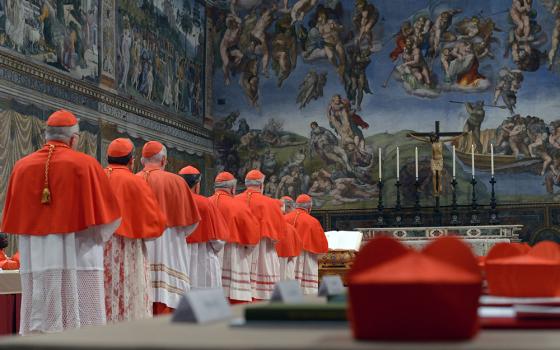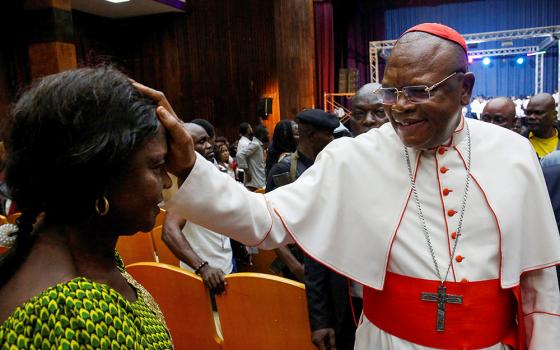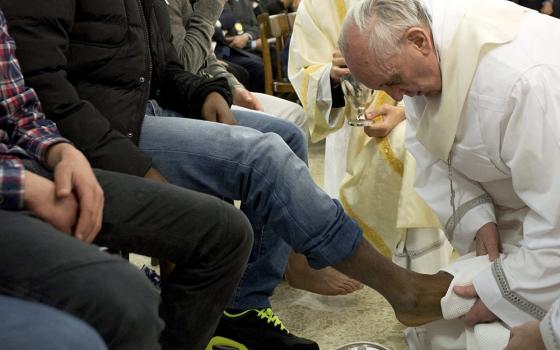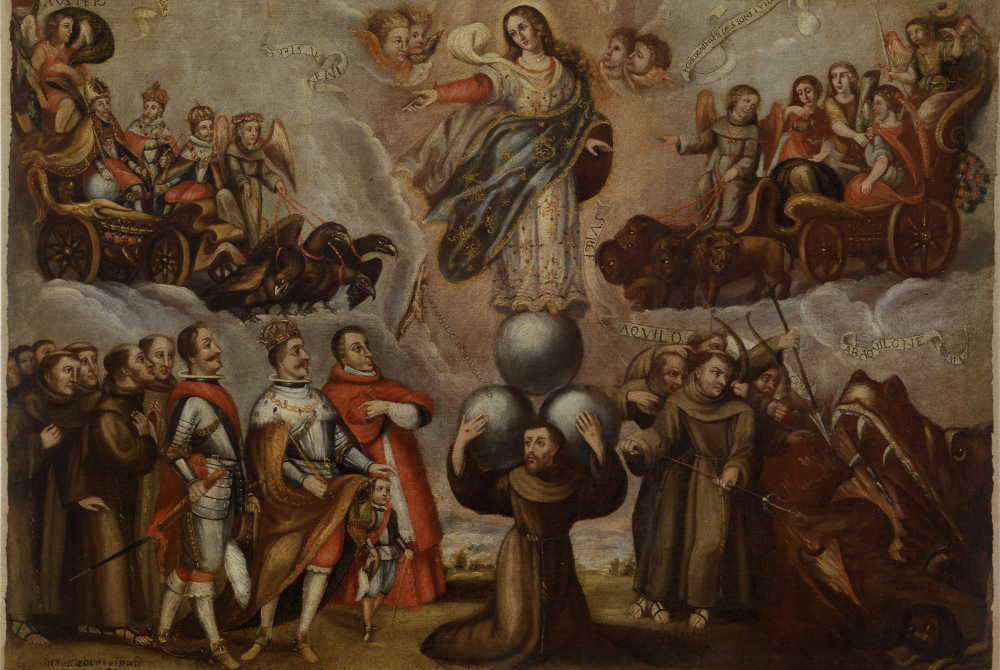
Eighteenth-century oil painting on canvas of "Franciscan Allegory in Honor of the Immaculate Conception" by an anonymous artist (National Museum of Mexican Art, Chicago)
In a process called tabula rasa, or "clean slate," Spanish Catholic priests, fueled by missionary zeal, arrived in Mexico and dismantled pre-Columbian (before Christopher Columbus) temples and broke, burned and buried cult statues. These missionaries replaced what they saw as indigenous pagan beliefs with Christian ones, as Gloria Fraser Giffords told it in the 1987 "Images of Faith" exhibit catalog.
Indigenous and Catholic rites proved so similar that early friars suggested Christians had previously contacted Mexico. "Perhaps, as one suggested, an apostle of Christ had somehow miraculously appeared and begun proselytizing among these people, who then backslid into barbaric pagan practices," Fraser Giffords added in the catalog.
More than 30 years after that inaugural exhibition at the Mexican Fine Arts Center Museum in Chicago's Pilsen neighborhood, a lot has changed. Scholars use rather different language today than the catalog did to describe indigenous peoples, and in 2006, the institution changed its name to the National Museum of Mexican Art. But it has remained in the same, but now-gentrifying, neighborhood, which was once more of a stronghold for Mexican immigrants.
The intersection of Mexican religion and culture is a cornerstone of the museum's displays, particularly in selections on view from its 10,000-object-strong permanent collection.
When I visited the museum last year as part of the Art Design Chicago festival, dozens of Catholic objects stood out, spanning from the Middle Ages to the present day. And just as the 1987 catalog laid out a complicated history, wherein Spanish colonizers helped the indigenous peoples in certain ways as they decimated their lives in others, the museum's displays today articulate those difficult interactions, which continue to shape Catholic Mexican and Catholic Mexican-American lives and beliefs.
In a recent interview, Cesáreo Moreno, the museum's visual arts director and chief curator, told a tale of two Spanish waves. Early Franciscan, Dominican and Augustinian missionaries were comparatively compassionate and brought technologies, such as the pottery wheel and aqueducts, to Mesoamerica.
Following the Protestant Reformation and the Counter Reformation, the Spanish Inquisition's moral policing influenced subsequent missionaries. From the 1560s until the late 18th century, Catholic missionaries erased traditional Mexican culture and life, particularly symbols and rituals that drew upon Mesoamerican cosmology.
"They came up with a pantheon of icons, in other words, 'If you're going to paint St. James the killer of Moors, this is how he is to be depicted. If you're to paint an image of the Nativity of Christ, these are the elements,' " Moreno said. "They really came down hard. Nothing was left to interpretation. Everything had to be copied exactly and believed in this one firm way."
What has continued to endure until today and what the missionaries couldn't completely stamp out despite their best efforts, according to Moreno, is Indo-Christian art, which draws upon both Catholic and indigenous beliefs. One of the most prominent examples of this synthesis is the Day of the Dead, in which many Mexicans believe that loved ones' souls return to visit their homes. Adherents await loved ones' arrivals in cemeteries and celebrate their lives through altars with offerings to the spirits in their homes.

"Virgen de Guadalupe" (Virgin of Guadalupe), attributed to Miguel Cabrera, oil on canvas, circa 1740 (National Museum of Mexican Art, Chicago)
"That is definitely not a Catholic idea. The pope does not think that souls have a vacation from heaven on Nov. 1 of every year when they get to go home and be with the family," Moreno said. "But in Mexico, it is part of the popular spiritual culture. It has both European and ancient American beliefs."
Although Mexican culture grew out of a violent European takeover, European and indigenous pre-Columbian Mexican cultures are irrevocably intertwined today.
"It wasn't a huge stretch of the imagination for the indigenous people to understand the story of God sending down his son to be sacrificed. A lot of these kinds of ideas really brought the two civilizations together in Mesoamerica," Moreno said. "We almost can't take them apart. It's like looking at the color purple and trying to take it apart. Is it blue, or is it red? It's neither. It's totally part of both."
The figure who has most bridged the two cultures in a mestizaje ("cultural blending") is the Virgin of Guadalupe. The museum displays a circa-1740 oil painting of the Virgin of Guadalupe that is attributed to Miguel Cabrera (1695-1768), whom it calls Mexico's most renowned colonial artist.
Cabrera, known for his biblical paintings and works depicting saints that adorn hundreds of Mexican churches and convents, was also a leading portrait artist who worked for colonial Mexican clergy, aristocrats and intellectuals, according to the museum.
But he was best known for his depictions of Guadalupe, whose image "quickly became synonymous with the emerging Mexican identity," the museum states. "As the image spread, so did pride in a national and cultural consciousness — a fully Mexican consciousness that would lead towards the independence movement and war with Spain within half a century."
Our Lady of Guadalupe, the embodiment of the Virgin Mary's 1531 appearance to Aztec Christian convert St. Juan Diego in a vision, continues to endure as a religious and national symbol, to which hundreds of thousands of annual visitors to her shrine attest, according to Britannica.
In the painting attributed to Cabrera, the crowned Virgin appears in prayer, supported by an angel underfoot. Stars appear on her deep blue robe and she is circumscribed by a golden oval with emanating rays of light.
The Virgin of Guadalupe "embodies the central theme to which any study of Mexican identity must inevitably return. The dark-skinned virgin is the most apt expression of the contact that occurred between the Spanish and the indigenous cultures," a museum label notes. "Whether one believes in the apparition of the Virgen de Guadalupe or not, the power of this icon is undeniable."
Advertisement
More complicated is the symbol of St. James Matamoros, or James, the slayer of Moors. The museum displays an early 19th-century painting of this saint by an unknown artist. In the picture, the saint lifts a sword over his head as he rides on horseback. His red-plumed helmet and his red robe are hemmed in gold. Gold also sparkles from the saddle, stirrups and bridle.
This anonymous artist placed this saint, said to have appeared to and inspired Christian soldiers in battle, in a landscape that is considerably less gory than other representations. A chapel devoted to the saint in Seville cathedral, for example, shows this saint and his horse treading on dead Moors. There have been some calls to remove artworks depicting him, including in Santiago de Compostela.
"The Spanish inquisition and St. James, the killer of Moors, were powerful ideas that sprang from the Reconquest of the Iberian Peninsula that saw the persecution of Moors and Jews in what became Spain," Moreno said. "The fervor of nationalism and religion followed the Spanish explorers that followed the conquistadors to the Americas."
Other standout objects at the museum include a 17th-century polychrome wooden sculpture of the infant Christ, a 19th-century polychrome wood and canvas crucifix and a 1960s altar for the dead by Olga Costa. Eighteenth- and 19th-century depictions of the Immaculate Conception, St. Luke the Evangelist, St. Anthony and the Tree of Life are also on view, and an 18th-century "Franciscan Allegory in Honor of the Immaculate Conception," copied from a Peter Paul Rubens sketch, is worth a close look.
"Mexicans, we have an age-old experience in this country, in that half of Mexico was taken by the United States in 1848, and so the thousands and thousands of Mexicans who overnight became U.S. citizens, we've had that experience, where the border crossed us."
— Cesáreo Moreno
The museum is currently in conversation with the Terra Foundation for American Art, which created the Art Design Chicago festival, to figure out a part two for the initiative. The museum's exhibit, "Arte Diseno Xicago: Mexican Inspiration from the World's Columbian Exposition to the Civil Rights Era," which the festival helped fund, brought loans from Mexico to the museum and two objects from the 1893 exposition. Terra, which "truly understands the role of art and culture and the humanities and really embraces it," has benefited the entire city, according to Moreno.
The Chicago Tribune also named the exhibit the city's top in 2018 for its demonstration that "the story of Mexican art here is in some essential way the story of Chicago art."
As the museum looks forward, it may also contend with a plan to create a National Museum of the American Latino on the National Mall, for which I've been receiving press releases for a few years now. I asked Moreno what it would mean to have such a museum with a national presence in Washington, even as the National Museum of Mexican Art is located in the Chicago's Pilsen neighborhood.
"There are pros and cons of course," said Moreno, who has worked with the Smithsonian Latino Center, which he said will open a gallery space in the National Museum of American History's first floor in the next year and a half.
"I really think it's going to be a very difficult thing to do," he said of the proposed national American Latino museum. "It's going to be a huge challenge, because just the term 'Latino' alone implies that we have a lot in common. And even though we do have much in common, we probably have many differences. It would be the equivalent of opening the national European museum. Would the labels be in German? Italian? Would they be in French? Would they be in English?"
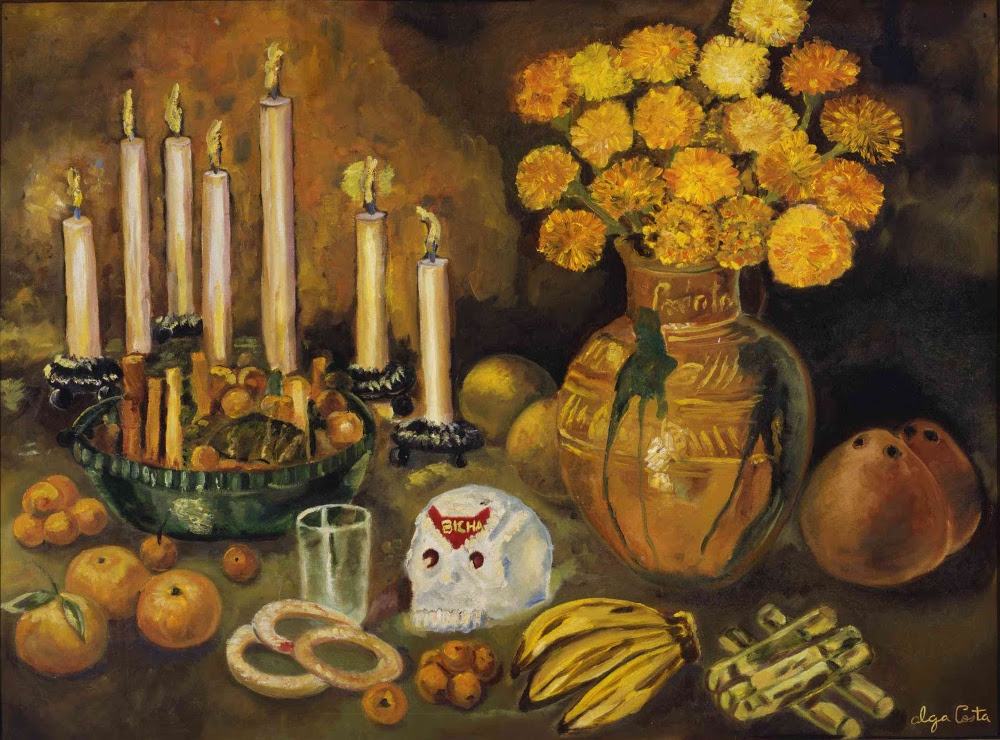
"Ofrenda de muertos" (Altar for the Dead ) by Olga Costa, oil on linen, 1965-67 (National Museum of Mexican Art, Chicago)
Even though Latinos basically speak Spanish and come from south of the U.S.-Mexican border, there are so many different experiences.
"The Cubans came here as political refugees in the very early '60s after the revolution happened; Puerto Ricans are sort of a territory, so they have a colonial kind of identity in the United States. They are citizens whose vote doesn't count, so they've got that experience," he said. "Mexicans, we have an age-old experience in this country, in that half of Mexico was taken by the United States in 1848, and so the thousands and thousands of Mexicans who overnight became U.S. citizens, we've had that experience, where the border crossed us."
"I can't even imagine how the artists or the curators are going to present a singular vision," he said, adding that the national museum makes more sense embedded in a Chicago neighborhood like Pilsen than on the East Coast, where many people erroneously think that this country began ex nihilo in the 17th century.
One thing is certain, though, if the proposed museum is created, it too will contend with the important and often troubling history of Catholicism in Latin and South America.
[Menachem Wecker is a freelance reporter in Washington, D.C.]



